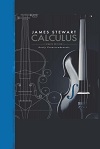About Us
Math shortcuts, Articles, worksheets, Exam tips, Question, Answers, FSc, BSc, MSc
More about usMath shortcuts, Articles, worksheets, Exam tips, Question, Answers, FSc, BSc, MSc
More about us
MathSchoolinternational contain thousands of
Mathematics Free Books and
Physics Free Books. Which cover almost all topics for students of Mathematics, Physics and Engineering. We have also collected other
Best Free Math Websites for teachers and students.
for teachers and students.
Here is extisive list of
Best Calculus Books . We hope students and teachers like these textbooks, notes and solution manuals.
Share this page:-

Congratulations, the link is avaliable for free download.
About this book :-
Calculus Early Transcendentals (8E) written by
James Stewart .
Success in your calculus course starts here! James Stewart's CALCULUS: EARLY TRANSCENDENTALS texts are world-wide best-sellers for a reason: they are clear, accurate, and filled with relevant, real-world examples. With CALCULUS: EARLY TRANSCENDENTALS, Eighth Edition, Stewart conveys not only the utility of calculus to help you develop technical competence, but also gives you an appreciation for the intrinsic beauty of the subject. His patient examples and built-in learning aids will help you build your mathematical confidence and achieve your goals in the course
Book Detail :-
Title: Calculus Early Transcendentals
Edition: 8th
Author(s): James Stewart
Publisher: Brooks/Cole
Series:
Year: 2016
Pages: 1397
Type: PDF
Language: English
ISBN: 1285741552,978-1-285-74155-0,978-1-305-27235-4
Country: Canada
Get this book from Amazon
About Author :-
Calculus Early Transcendentals (8th Edition) written by
James Stewart .
He received his M. S. (master of science) at Stanford University and his Ph.D. (doctor of philosophy) from the University of Toronto.
He worked as a postdoctoral fellow at the University of London, where his research focused on harmonic and functional analysis. Stewart was most recently Professor of Mathematics at McMaster University, and his research field was harmonic analysis. Stewart was the author of a best calculus textbook series published by Cengage Learning, including Calculus, Calculus: Early Transcendentals and Calculus: Concepts and Contexts, as well as a series of precalculus texts.
All Famous Books of this Author :-
Here is list all books, text books, editions, versions or solution manuals avaliable of this author, We recomended you to download all.
• Download PDF Biocalculus: Calculus for Life Sciences by James Stewart 
• Download PDF Biocalculus: Calculus for Life Sciences (Solution) by James Stewart 
• Download PDF Precalculus Mathematics for Calculus (6E) by James Stewart 
• Download PDF Precalculus Mathematics for Calculus (7E) by James Stewart 
• Download PDF Essential Calculus (2E) by James Stewart 
• Download PDF Essential Calculus (2E Solution) by James Stewart 
• Download PDF Calculus (5E) by James Stewart 
• Download PDF Multivariable Calculus (5E) by James Stewart 
• Download PDF Calculus Early Transcendentals (7E) by James Stewart 
• Download PDF Calculus Early Transcendentals (7E Solution) by James Stewart 
• Download PDF Calculus Early Transcendentals (8E) by James Stewart 
• Download PDF Calculus Early Transcendentals (8E Solution) by James Stewart 
• Download PDF Single Variable Calculus Early Transcendentals (9E) by James Stewart 
Join our new updates, alerts:-
For new updates and alerts join our WhatsApp Group and Telegram Group (you can also ask any [pdf] book/notes/solutions manual).
 Join WhatsApp Group
Join WhatsApp Group
 Join Telegram Group
Join Telegram Group
Book Contents :-
Calculus Early Transcendentals (8E) written by
James Stewart
cover the following topics.
1. FUNCTIONS AND MODELS.
Four Ways to Represent a Function. Mathematical Models: A Catalog of Essential Functions. New Functions from Old Functions. Graphing Calculators and Computers. Principles of Problem Solving.
2. LIMITS.
The Tangent and Velocity Problems. The Limit of a Function. Calculating Limits Using the Limit Laws. The Precise Definition of a Limit. Continuity.
3. DERIVATIVES.
Derivatives and Rates of Change. Writing Project: Early Methods for Finding Tangents. The Derivative as a Function. Differentiation Formulas. Applied Project: Building a Better Roller Coaster. Derivatives of Trigonometric Functions. The Chain Rule. Applied Project: Where Should a Pilot Start Descent?. Imlicit Differentiation. Rates of Change in the Natural and Social Sciences. Related Rates. Linear Approximations and Differentials. Laboratory Project: Taylor Polynomials.
4. APPLICATIONS OF DIFFERENTIATION.
Maximum and Minimum Values. Applied Project: The Calculus of Rainbows. The Mean Value Theorem. How Derivatives Affect the Shape of a Graph. Limits at Infinity; Horizontal Asymptotes. Summary of Curve Sketching. Graphing with Calculus and Calculators. Optimization Problems. Applied Project: The Shape of a Can. Newton's Method. Antiderivatives.
5. INTEGRALS.
Areas and Distances. The Definite Integral. Discovery Project: Area Functions. The Fundamental Theorem of Calculus. Indefinite Integrals and the Net Change Theorem. Writing Project: Newton, Leibniz, and the Invention of Calculus. The Substitution Rule.
6. APPLICATIONS OF INTEGRATION.
Areas between Curves. Volume. Volumes by Cylindrical Shells. Work. Average Value of a Function.
7. INVERSE FUNCTIONS:
EXPONENTIAL, LOGARITHMIC, AND INVERSE TRIGONOMETRIC FUNCTIONS. Inverse Functions. (Instructors may cover either Sections 7.2-7.4 or Sections 7.2*-7.4*). Exponential Functions and Their Derivatives. Logarithmic Functions. Derivatives of Logarithmic Functions. *The Natural Logarithmic Function. *The Natural Exponential Function. *General Logarithmic and Exponential Functions. Exponential Growth and Decay. Inverse Trigonometric Functions. Applied Project: Where to Sit at the Movies. Hyperbolic Functions. Indeterminate Forms and L'Hospital's Rule. Writing Project: The Origins of L'Hospital's Rule.
8. TECHNIQUES OF INTEGRATION.
Integration by Parts. Trigonometric Integrals. Trigonometric Substitution. Integration of Rational Functions by Partial Fractions. Strategy for Integration. Integration Using Tables and Computer Algebra Systems. Discovery Project: Patterns in Integrals. Approximate Integration. Improper Integrals.
9. FURTHER APPLICATIONS OF INTEGRATION.
Arc Length. Discovery Project: Arc Length Contest. Area of a Surface of Revolution. Discovery Project: Rotating on a Slant. Applications to Physics and Engineering. Discovery Project: Complementary Coffee Cups. Applications to Economics and Biology. Probability.
10. DIFFERENTIAL EQUATIONS.
Modeling with Differential Equations. Direction Fields and Euler's Method. Separable Equations. Applied Project: Which is Faster, Going Up or Coming Down? Models for Population Growth. Applied Project: Calculus and Baseball. Linear Equations. Predator-Prey Systems.
PARAMETRIC Equations and Polar Coordinates.
Curves Defined by Parametric Equations. Laboratory Project: Families of Hypocycloids. Calculus with Parametric Curves. Laboratory Project: Bezier Curves. Polar Coordinates. Areas and Lengths in Polar Coordinates. Conic Sections. Conic Sections in Polar Coordinats.
11. INFINITE SEQUENCES AND SERIES.
Sequences. Laboratory Project: Logistic Sequences. Series. The Integral Test and Estimates of Sums. The Comparison Tests. Alternating Series. Absolute Convergence and the Ratio and Root Tests. Strategy for Testing Series. Power Series. Representation of Functions as Power Series. Taylor and Maclaurin Series. Writing Project: How Newton Discovered the Binomial Series. Applications of Taylor Polynomials. Applied Project: Radiation from the Stars.
12. VECTORS AND THE GEOMETRY OF SPACE.
Three-Dimensional Coordinate Systems. Vectors. The Dot Product. The Cross Product. Discovery Project: The Geometry of a Tetrahedron. Equations of Lines and Planes. Cylinders and Quadric Surfaces.
13. VECTOR FUNCTIONS.
Vector Functions and Space Curves. Derivatives and Integrals of Vector Functions. Arc Length and Curvature. Motion in Space: Velocity and Acceleration. Applied Project: Kepler's Laws.
14. PARTIAL DERIVATIVES.
Functions of Several Variables. Limits and Continuity. Partial Derivatives. Tangent Planes and Linear Approximations. The Chain Rule. Directional Derivatives and the Gradient Vector. Maximum and Minimum Values. Applied Project: Designing a Dumpster. Discovery Project: Quadratic Approximations and Critical Points. Lagrange Multipliers. Applied Project: Rocket Science. Applied Project: Hydro-Turbine Optimization.
15. MULTIPLE INTEGRALS.
Double Integrals over Rectangles. Iterated Integrals. Double Integrals over General Regions. Double Integrals in Polar Coordinates. Applications of Double Integrals. Triple Integrals. Discovery Project: Volumes of Hyperspheres. Triple Integrals in Cylindrical. Discovery Project: The Intersection of Three Cylinders. Triple Integrals in Spherical Coordinates. Applied Project: Roller Derby. Change of Variables in Multiple Integrals. 17. VECTOR CALCULUS. Vector Fields. Line Integrals. The Fundamental Theorem for Line Integrals. Green's Theorem. Curl and Divergence. Parametric Surfaces and Their Areas. Surface Integrals. Stokes' Theorem. Writing Project: Three Men and Two Theorems. The Divergence Theorem. Summary.
16. VECTOR CALCULUS
Vector Fields, Line Integrals, The Fundamental Theorem for Line Integrals, Green’s Theorem, Curl and Divergence, Parametric Surfaces and Their Areas, Surface Integrals, Stokes’ Theorem, Writing Project • Three Men and Two Theorems, The Divergence Theorem
17. SECOND-ORDER DIFFERENTIAL EQUATIONS.
Second-Order Linear Equations. Nonhomogeneous Linear Equations. Applications of Second-Order Differential Equations. Series Solutions.
Appendixes.
A: Intervals, Inequalities, and Absolute Values. B: Coordinate Geometry and Lines. C: Graphs of Second-Degree Equations. D: Trigonometry. E: Sigma Notation. F: Proofs of Theorems. G. Complex Numbers. H: Answers to Odd-Numbered Exercises.
Note:-
We are not the owner of this book/notes. We provide it which is already avialable on the internet. For any further querries please contact us. We never SUPPORT PIRACY. This copy was provided for students who are financially troubled but want studeing to learn. If You Think This Materials Is Useful, Please get it legally from the PUBLISHERS. Thank you.
